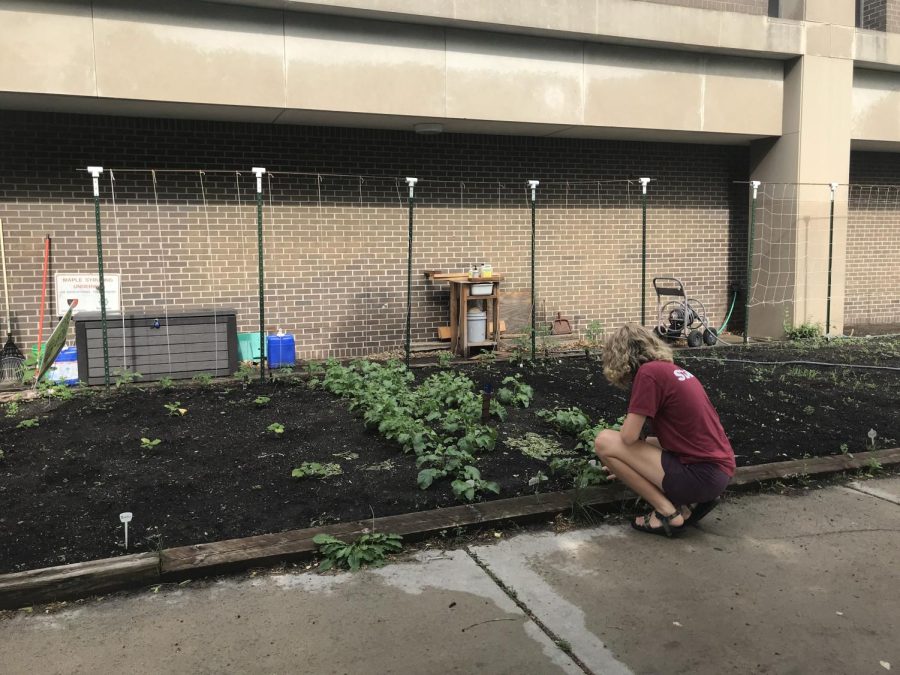Outdoor education supports students’ mental health and offers unique learning opportunities
AP Environmental Science student Ingrid Noren harvests radishes from the South garden. South’s Environmental Science teacher Susan Peterson advocates for outdoor learning, saying that “working in the soil can support both our physical and mental health.”
June 8, 2023
Outdoor education can be a contentious issue at schools like South. Bringing students outside of the classroom can open up a host of new learning opportunities, but can also lead to problems with safety and liability. As students experience burnout towards the end of the school year, working in an outdoor environment can help them to focus and engage with content, but the outdoors can also be distracting or uncomfortable. Teaching outdoors brings new challenges with equal rewards to teachers.
As the weather gets warmer and the school year draws to a close, spending time outdoors has an especially important impact on students who might otherwise be bored in school or skip class in favor of being outside with friends. Some teachers at South, particularly in the science department, already make outdoor learning an important part of their classes. Other teachers should explore options for teaching outdoors, both to enhance the education that students receive and also to promote the well-being of students and teachers alike.
Biology, taught by Mick Hamilton, is one class at South that involves a lot of time spent outdoors. In the fall and spring, students in Hamilton’s General Biology and AP Biology classes often participate in outside observation at Corcoran Park, a community park a few blocks away from South. Macy Gearhart, a student in AP Biology, describes classes at Corcoran as opportunities to “observe nature, notice things, draw pictures, write questions, all about the outside world.”
For Hamilton, one of the most important benefits of outdoor education is that it helps students to recognize how they can interact with nature, even within an urban setting. “We’re in this huge city, and there’s still so much cool nature in our backyard and in our neighborhood,” he says. “That’s why I really thought it was important to get students outside in the fall to see what was going on.” In the spring, there’s also the benefit of allowing students who are stressed or burned out to learn in a more relaxed environment. Hamilton says that outdoor learning “acts as a good pressure valve,” giving students the chance to “get out to the park, or out to our gardens, and just sit with nature and maybe do a little work and maybe just breathe and relax.”
Another South class that often spends time outdoors is AP Environmental Science, taught by Susan Peterson. This spring, her students have been working in South’s gardens, which are located along the west edge of the practice field, and in front of the school on 32nd Street. The Environmental Science class has seeded the front lawn with a pollinator-friendly mix of plants, set up new garden plots, and planted and harvested vegetables such as beets and radishes. Peterson’s students also went on a field trip to Minnehaha Falls along with some of her chemistry students, and participated in an on-site field trip to observe South’s bees and learn about honeybees and hives.
Although outdoor education is a big component of Peterson’s teaching, she recognizes that it does come with challenges. “Students may not recognize that the classroom extends beyond the doors,” she says. Distractions can be a bigger issue outside the classroom, especially if students are generally disposed to think of the outdoors as a play space rather than an educational one. “Teachers [also] need to take into account the needs of students when they are outside,” says Peterson. “Do they have the right clothing to be comfortable? Is there a mix of sun and shade? Do [they] have access to water and bathrooms? What about students who come late?” There are many considerations to address that can make it more difficult for teachers to envision the outdoors as a learning environment.
Despite those challenges, Peterson also sees outdoor learning as a form of education with many benefits. One is that it allows students to engage with content and with their teachers in a new way. She says that “outdoors, students can be more active in their learning… Teachers can take classroom learning and apply it to a ‘real-world’ situation or have students look at academic concepts using objects in the environment.” Like Hamilton, Peterson also believes that part of the importance of outdoor education is the ability to give students access to the outdoors. “So many children do not have access to outdoor or nature experiences. Without connection to the environment, we lose appreciation and fail to see the need to maintain our natural areas,” she says. “I want students to know that even though they live in an urban area, there are still natural areas that they can take advantage of.”
Outdoor education has clear applications to science classes, but teachers in other fields should also look for ways to incorporate the outdoors into their class experiences. An important reason for this is the impact that time spent outside has on mental health. Getting a break from sitting in a classroom and being able to interact with nature benefits both students and teachers. South sophomore Iris Noren says that when students are “just doing a worksheet or doing something that could be done outside instead of inside, it would be helpful if we could just sit on the practice field or at the park to do that… it would help me focus more and be a little happier.”
For teachers, it can sometimes be difficult to justify time spent outdoors that might not lead directly to improved academic performance or test scores. However, grades and test scores are only one aspect of education, and teachers and students who advocate for outdoor learning believe that the benefits – to a well-rounded education and to mental health – outweigh the potential costs. “Do we test mental well-being?” Hamilton asks. “No, not really. But it’s just as important as… the other experiences we get in class. Nature is good for everybody, and we just need to get out and play in the dirt.”






